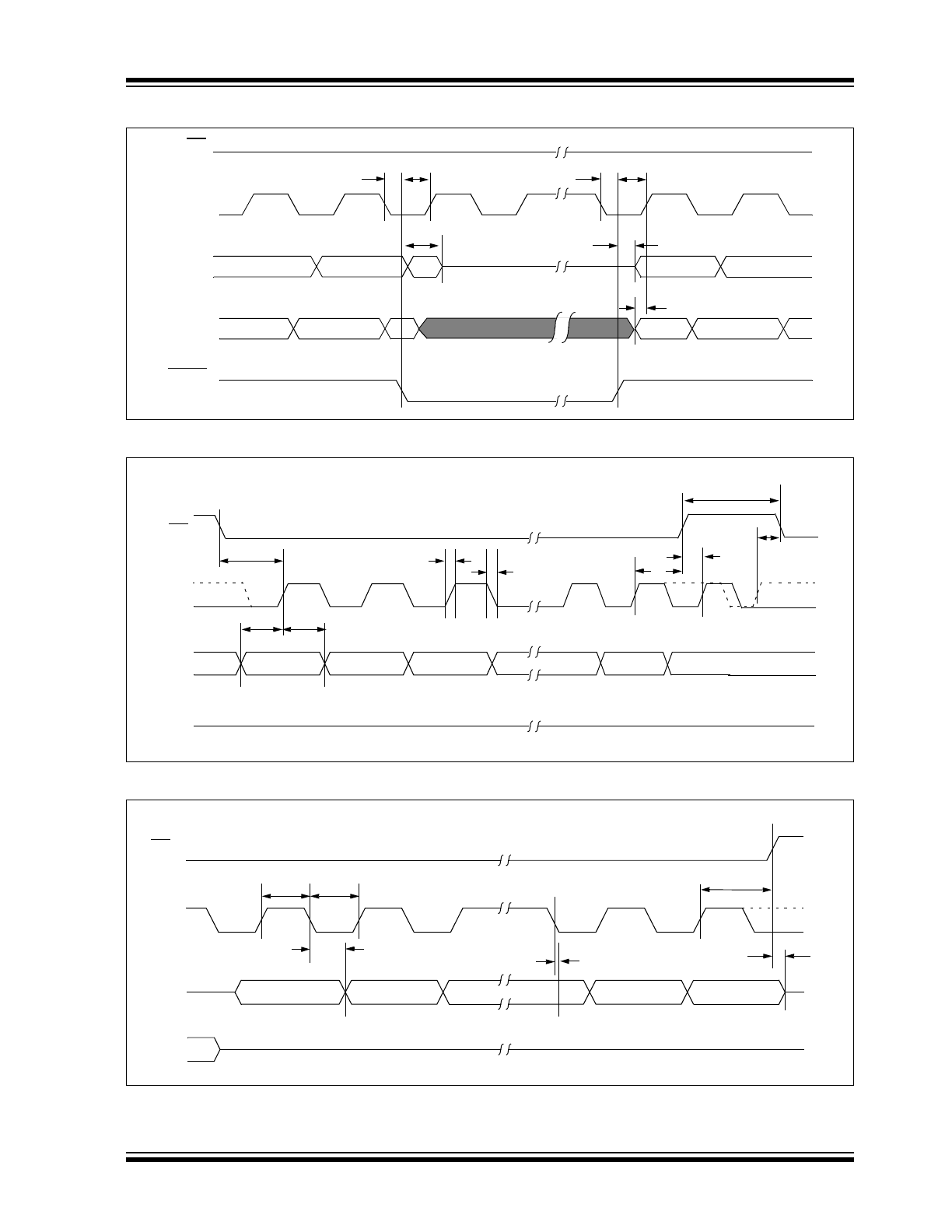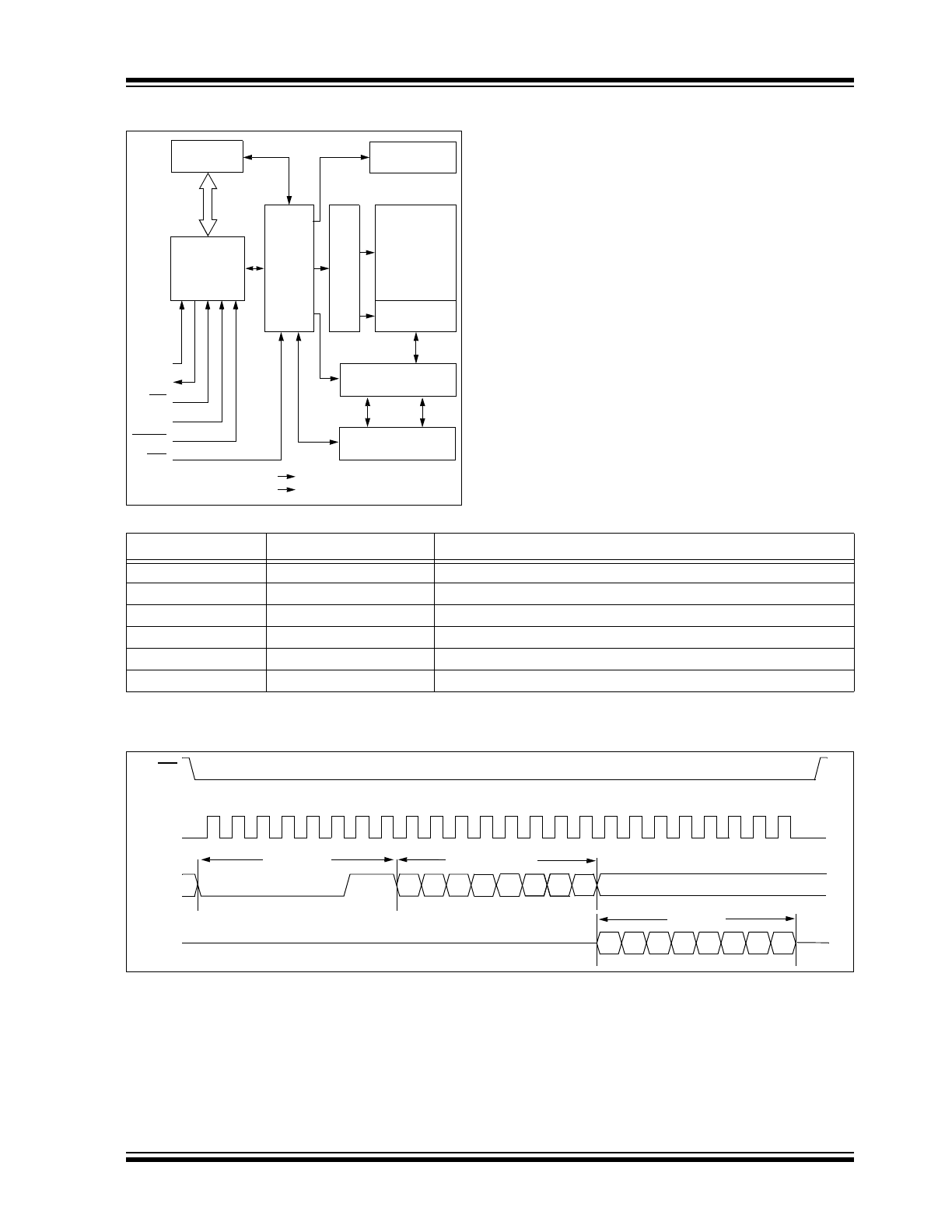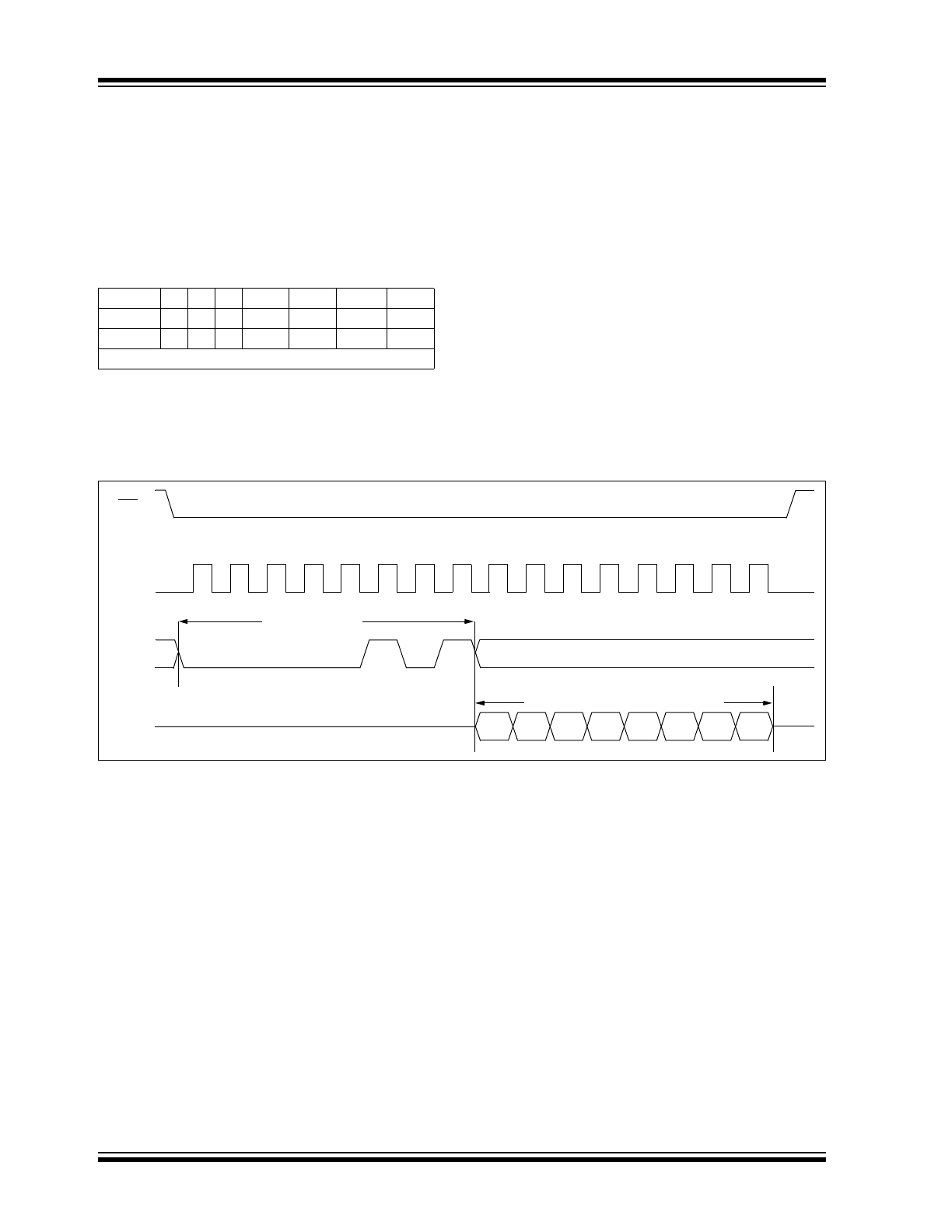
2003-2012 Microchip Technology Inc.
DS21833G-page 1
25AA020A/25LC020A
Device Selection Table
Features:
• 10 MHz max. Clock Frequency
• Low-Power CMOS Technology:
- Max. Write Current: 5 mA at 5.5V, 10 MHz
- Read Current: 5 mA at 5.5V, 10 MHz
- Standby Current: 5
A at 5.5V
• 256 x 8-bit Organization
• Write Page mode (up to 16 bytes)
• Sequential Read
• Self-Timed Erase and Write Cycles (5 ms max.)
• Block Write Protection:
- Protect none, 1/4, 1/2 or all of array
• Built-in Write Protection:
- Power-on/off data protection circuitry
- Write enable latch
- Write-protect pin
• High Reliability:
- Endurance: 1,000,000 Erase/Write cycles
- Data retention: >200 years
- ESD protection: >4000V
• Temperature Ranges Supported:
• Pb-Free and RoHS Compliant
Pin Function Table
Description:
The Microchip Technology Inc. 25XX020A* is a 2 Kbit
Serial Electrically Erasable Programmable Read-Only
Memory (EEPROM). The memory is accessed via a
simple Serial Peripheral Interface (SPI) compatible
serial bus. The bus signals required are a clock input
(SCK) plus separate data in (SI) and data out (SO)
lines. Access to the device is controlled through a Chip
Select (CS) input.
Communication to the device can be paused via the
hold pin (HOLD). While the device is paused, transi-
tions on its inputs will be ignored, with the exception of
Chip Select, allowing the host to service higher priority
interrupts.
The 25XX020A is available in standard packages
including 8-lead PDIP and SOIC, and advanced
packages including 8-lead MSOP, 8-lead TSSOP and
rotated TSSOP, 8-lead 2x3 DFN and TDFN, and 6-lead
SOT-23.
Package Types (not to scale)
Part Number
V
CC
Range
Page Size
Temp. Ranges
Packages
25AA020A
1.8-5.5V
16 Bytes
I
P, MS, SN, ST, MN, MC, OT
25LC020A
2.5-5.5V
16 Bytes
I, E
P, MS, SN, ST, MN, MC, OT
- Industrial (I):
-40
C to +85C
- Automotive (E):
-40
C to +125C
Name
Function
CS
Chip Select Input
SO
Serial Data Output
WP
Write-Protect
V
SS
Ground
SI
Serial Data Input
SCK
Serial Clock Input
HOLD
Hold Input
V
CC
Supply Voltage
CS
SO
WP
V
SS
1
2
3
4
8
7
6
5
V
CC
HOLD
SCK
SI
(P, SN)
TSSOP/MSOP
CS
SO
WP
V
SS
1
2
3
4
8
7
6
5
V
CC
HOLD
SCK
SI
(ST, MS)
PDIP/SOIC
V
SS
1
2
3
4
6
5
V
DD
CS
SO
(OT)
X-Rotated TSSOP
HOLD
V
CC
CS
SO
1
2
3
4
8
7
6
5
SCK
SI
V
SS
WP
(X/ST)
SOT-23
SCK
SI
CS
SO
WP
V
SS
1
2
3
4
8
7
6
5
V
CC
HOLD
SCK
SI
(MC, MN)
DFN/TDFN
2K SPI Bus Serial EEPROM
*25XX020A is used in this document as a generic part
number for the 25AA020A and the 25LC020A.

25AA020A/25LC020A
DS21833G-page 2
2003-2012 Microchip Technology Inc.
1.0
ELECTRICAL CHARACTERISTICS
Absolute Maximum Ratings
(†)
V
CC
.............................................................................................................................................................................6.5V
All inputs and outputs w.r.t. V
SS
......................................................................................................... -0.6V to V
CC
+1.0V
Storage temperature .................................................................................................................................-65°C to 150°C
Ambient temperature under bias ...............................................................................................................-40°C to 125°C
ESD protection on all pins ..........................................................................................................................................4 kV
TABLE 1-1:
DC CHARACTERISTICS
† NOTICE: Stresses above those listed under “Absolute Maximum Ratings” may cause permanent damage to the
device. This is a stress rating only and functional operation of the device at those or any other conditions above those
indicated in the operational listings of this specification is not implied. Exposure to maximum rating conditions for an
extended period of time may affect device reliability.
DC CHARACTERISTICS
Industrial (I):
T
A
= -40°C to +85°C
V
CC
= 1.8V to 5.5V
Automotive (E):
T
A
= -40°C to +125°C
V
CC
= 2.5V to 5.5V
Param.
No.
Sym.
Characteristic
Min.
Max.
Units
Test Conditions
D001
V
IH
1
High-level Input
Voltage
0.7 V
CC
V
CC
+1
V
D002
V
IL
1
Low-level Input
Voltage
-0.3
0.3 V
CC
V
V
CC
2.7V (
Note 1
)
D003
V
IL
2
-0.3
0.2 V
CC
V
V
CC
< 2.7V (
Note 1
)
D004
V
OL
Low-level Output
Voltage
—
0.4
V
I
OL
= 2.1 mA
D005
V
OL
—
0.2
V
I
OL
= 1.0 mA, V
CC
< 2.5V
D006
V
OH
High-level Output
Voltage
V
CC
-0.5
—
V
I
OH
= -400
A
D007
I
LI
Input Leakage
Current
—
±1
A
CS = V
CC
, V
IN
= V
SS
or V
CC
D008
I
LO
Output Leakage
Current
—
±1
A
CS = V
CC
, V
OUT
= V
SS
or V
CC
D009
C
INT
Internal Capacitance
(all inputs and
outputs)
—
7
pF
T
A
= 25°C, CLK = 1.0 MHz,
V
CC
= 5.0V (
Note 1
)
D010
I
CC
Read
Operating Current
—
—
5
2.5
mA
mA
V
CC
= 5.5V; F
CLK
= 10.0 MHz;
SO = Open
V
CC
= 2.5V; F
CLK
= 5.0 MHz;
SO = Open
D011
I
CC
Write
—
—
5
3
mA
mA
V
CC
= 5.5V
V
CC
= 2.5V
D012
I
CCS
Standby Current
—
—
5
1
A
A
CS = V
CC
= 5.5V, Inputs tied to V
CC
or
V
SS
, T
A
= +125°C
CS = V
CC
= 2.5V, Inputs tied to V
CC
or
V
SS
, T
A
= +85°C
Note:
This parameter is periodically sampled and not 100% tested.

2003-2012 Microchip Technology Inc.
DS21833G-page 3
25AA020A/25LC020A
TABLE 1-2:
AC CHARACTERISTICS
AC CHARACTERISTICS
Industrial (I):
T
A
= -40°C to +85°C
V
CC
= 1.8V to 5.5V
Automotive (E): T
A
= -40°C to +125°C
V
CC
= 2.5V to 5.5V
Param.
No.
Sym.
Characteristic
Min.
Max.
Units
Test Conditions
1
F
CLK
Clock Frequency
—
—
—
10
5
3
MHz
MHz
MHz
4.5V
V
CC
5.5V
2.5V
V
CC
4.5V
1.8V
V
CC
2.5V
2
T
CSS
CS Setup Time
50
100
150
—
—
—
ns
ns
ns
4.5V
V
CC
5.5V
2.5V
V
CC
4.5V
1.8V
V
CC
2.5V
3
T
CSH
CS Hold Time
100
200
250
—
—
—
ns
ns
ns
4.5V
V
CC
5.5V
2.5V
V
CC
4.5V
1.8V
V
CC
2.5V
4
T
CSD
CS Disable Time
50
—
ns
—
5
Tsu
Data Setup Time
10
20
30
—
—
—
ns
ns
ns
4.5V
V
CC
5.5V
2.5V
V
CC
4.5V
1.8V
V
CC
2.5V
6
T
HD
Data Hold Time
20
40
50
—
—
—
ns
ns
ns
4.5V
V
CC
5.5V
2.5V
V
CC
4.5V
1.8V
V
CC
2.5V
7
T
R
CLK Rise Time
—
100
ns
(
Note 1
)
8
T
F
CLK Fall Time
—
100
ns
(
Note 1
)
9
T
HI
Clock High Time
50
100
150
—
—
—
ns
ns
ns
4.5V
V
CC
5.5V
2.5V
V
CC
4.5V
1.8V
V
CC
2.5V
10
T
LO
Clock Low Time
50
100
150
—
—
—
ns
ns
ns
4.5V
V
CC
5.5V
2.5V
V
CC
4.5V
1.8V
V
CC
2.5V
11
T
CLD
Clock Delay Time
50
—
ns
—
12
T
CLE
Clock Enable Time
50
—
ns
—
13
T
V
Output Valid from Clock
Low
—
—
—
50
100
160
ns
ns
ns
4.5V
V
CC
5.5V
2.5V
V
CC
4.5V
1.8V
V
CC
2.5V
14
T
HO
Output Hold Time
0
—
ns
(
Note 1
)
15
T
DIS
Output Disable Time
—
—
—
40
80
160
ns
ns
ns
4.5V
V
CC
5.5V (
Note 1
)
2.5V
V
CC
4.5V (
Note 1
)
1.8V
V
CC
2.5V (
Note 1
)
16
T
HS
HOLD Setup Time
20
40
80
—
—
—
ns
ns
ns
4.5V
V
CC
5.5V
2.5V
V
CC
4.5V
1.8V
V
CC
2.5V
Note 1: This parameter is periodically sampled and not 100% tested.
2: This parameter is not tested but ensured by characterization. For endurance estimates in a specific
application, please consult the Total Endurance™ Model which can be obtained from Microchip’s web site
at www.Microchip.com.
3: T
WC
begins on the rising edge of CS after a valid write sequence and ends when the internal write cycle
is complete.

25AA020A/25LC020A
DS21833G-page 4
2003-2012 Microchip Technology Inc.
TABLE 1-3:
AC TEST CONDITIONS
17
T
HH
HOLD Hold Time
20
40
80
—
—
—
ns
ns
ns
4.5V
V
CC
5.5V
2.5V
V
CC
4.5V
1.8V
V
CC
2.5V
18
T
HZ
HOLD Low to Output
High-Z
30
60
160
—
—
—
ns
ns
ns
4.5V
V
CC
5.5V (
Note 1
)
2.5V
V
CC
4.5V (
Note 1
)
1.8V
V
CC
2.5V (
Note 1
)
19
T
HV
HOLD High to Output
Valid
30
60
160
—
—
—
ns
ns
ns
4.5V
V
CC
5.5V
2.5V
V
CC
4.5V
1.8V
V
CC
2.5V
20
T
WC
Internal Write Cycle Time
(byte or page)
—
5
ms
(
Note 3
)
21
—
Endurance
1M
—
E/W
Cycles
25°C, V
CC
= 5.5V (
N
OTE
2
)
TABLE 1-2:
AC CHARACTERISTICS (CONTINUED)
AC CHARACTERISTICS
Industrial (I):
T
A
= -40°C to +85°C
V
CC
= 1.8V to 5.5V
Automotive (E): T
A
= -40°C to +125°C
V
CC
= 2.5V to 5.5V
Param.
No.
Sym.
Characteristic
Min.
Max.
Units
Test Conditions
Note 1: This parameter is periodically sampled and not 100% tested.
2: This parameter is not tested but ensured by characterization. For endurance estimates in a specific
application, please consult the Total Endurance™ Model which can be obtained from Microchip’s web site
at www.Microchip.com.
3: T
WC
begins on the rising edge of CS after a valid write sequence and ends when the internal write cycle
is complete.
AC Waveform:
V
LO
= 0.2V
—
V
HI
= V
CC
- 0.2V
(
Note 1
)
V
HI
= 4.0V
(
Note 2
)
C
L
= 100 pF
—
Timing Measurement Reference Level
Input
0.5 V
CC
Output
0.5 V
CC
Note 1: For V
CC
4.0V
2: For V
CC
4.0V

2003-2012 Microchip Technology Inc.
DS21833G-page 5
25AA020A/25LC020A
FIGURE 1-1:
HOLD TIMING
FIGURE 1-2:
SERIAL INPUT TIMING
FIGURE 1-3:
SERIAL OUTPUT TIMING
CS
SCK
SO
SI
HOLD
17
16
16
17
19
18
Don’t Care
5
High-Impedance
n + 2
n + 1
n
n - 1
n
n + 2
n + 1
n
n
n - 1
CS
SCK
SI
SO
6
5
8
7
11
3
LSB in
MSB in
High-Impedance
12
Mode 1,1
Mode 0,0
2
4
CS
SCK
SO
10
9
13
MSB out
ISB out
3
15
Don’t Care
SI
Mode 1,1
Mode 0,0
14

25AA020A/25LC020A
DS21833G-page 6
2003-2012 Microchip Technology Inc.
2.0
FUNCTIONAL DESCRIPTION
2.1
Principles of Operation
The 25XX020A is a 256-byte Serial EEPROM
designed to interface directly with the Serial Peripheral
Interface (SPI) port of many of today’s popular
microcontroller families, including Microchip’s PIC
®
microcontrollers. It may also interface with microcon-
trollers that do not have a built-in SPI port by using
discrete I/O lines programmed properly in software to
match the SPI protocol.
The 25XX020A contains an 8-bit instruction register.
The device is accessed via the SI pin, with data being
clocked in on the rising edge of SCK. The CS pin must
be low and the HOLD pin must be high for the entire
operation.
Table 2-1
contains a list of the possible instruction
bytes and format for device operation. All instructions,
addresses, and data are transferred MSb first, LSb last.
Data (SI) is sampled on the first rising edge of SCK
after CS goes low. If the clock line is shared with other
peripheral devices on the SPI bus, the user can assert
the HOLD input and place the 25XX020A in ‘HOLD’
mode. After releasing the HOLD pin, operation will
resume from the point when the HOLD was asserted.
2.2
Read Sequence
The device is selected by pulling CS low. The 8-bit
READ instruction is transmitted to the 25XX020A
followed by an 8-bit address. See Figure 2-1 for more
details.
After the correct READ instruction and address are sent,
the data stored in the memory at the selected address
is shifted out on the SO pin. Data stored in the memory
at the next address can be read sequentially by
continuing to provide clock pulses to the slave. The
internal Address Pointer automatically increments to
the next higher address after each byte of data is
shifted out. When the highest address is reached
(FFh), the address counter rolls over to address 00h
allowing the read cycle to be continued indefinitely. The
read operation is terminated by raising the CS pin
(
Figure 2-1
).
2.3
Write Sequence
Prior to any attempt to write data to the 25XX020A, the
write enable latch must be set by issuing the WREN
instruction (
Figure 2-4
). This is done by setting CS low
and then clocking out the proper instruction into the
25XX020A. After all eight bits of the instruction are
transmitted, CS must be driven high to set the write
enable latch. If the write operation is initiated immedi-
ately after the WREN instruction without CS driven high,
data will not be written to the array since the write
enable latch was not properly set.
After setting the write enable latch, the user may
proceed by driving CS low, issuing a WRITE instruction,
followed by the remainder of the address, and then the
data to be written. Up to 16 bytes of data can be sent to
the device before a write cycle is necessary. The only
restriction is that all of the bytes must reside in the
same page. Additionally, a page address begins with
XXXX 0000 and ends with XXXX 1111. If the internal
address counter reaches XXXX 1111 and clock signals
continue to be applied to the chip, the address counter
will roll back to the first address of the page and over-
write any data that previously existed in those
locations.
For the data to be actually written to the array, the CS
must be brought high after the Least Significant bit (D0)
of the n
th
data byte has been clocked in. If CS is driven
high at any other time, the write operation will not be
completed. Refer to
Figure 2-2
and
Figure 2-3
for more
detailed illustrations on the byte write sequence and
the page write sequence respectively. While the write is
in progress, the STATUS register may be read to check
the status of the WIP, WEL, BP1 and BP0 bits
(
Figure 2-6
). Attempting to read a memory array
location will not be possible during a write cycle. Polling
the WIP bit in the STATUS register is recommended in
order to determine if a write cycle is in progress. When
the write cycle is completed, the write enable latch is
reset.
Note:
Page write operations are limited to
writing bytes within a single physical page,
regardless of the number of bytes
actually being written. Physical page
boundaries start at addresses that are
integer multiples of the page buffer size
(or ‘page size’) and, end at addresses that
are integer multiples of page size – 1. If a
Page Write command attempts to write
across a physical page boundary, the
result is that the data wraps around to the
beginning of the current page (overwriting
data previously stored there), instead of
being written to the next page as might be
expected. It is therefore necessary for the
application software to prevent page write
operations that would attempt to cross a
page boundary.

2003-2012 Microchip Technology Inc.
DS21833G-page 7
25AA020A/25LC020A
BLOCK DIAGRAM
FIGURE 2-1:
READ SEQUENCE
SI
SO
SCK
CS
HOLD
WP
STATUS
Register
I/O Control
Memory
Control
Logic
X
Dec
HV Generator
EEPROM
Array
Page Latches
Y Decoder
Sense Amp.
R/W Control
Logic
V
CC
V
SS
TABLE 2-1:
INSTRUCTION SET
Instruction Name
Instruction Format
Description
READ
0000 x011
Read data from memory array beginning at selected address
WRITE
0000 x010
Write data to memory array beginning at selected address
WRDI
0000 x100
Reset the write enable latch (disable write operations)
WREN
0000 x110
Set the write enable latch (enable write operations)
RDSR
0000 x101
Read STATUS register
WRSR
0000 x001
Write STATUS register
x
= don’t care
SO
SI
SCK
CS
0
2
3
4
5
6
7
8
9 10 11
1
0
1
0
0
0
0
0
1
A
7
A
6
A
5
A
4
A
1
A
0
7
6
5
4
3
2
1
0
Data Out
High-Impedance
A
3
A
2
Address Byte
12 13 14 15 16 17 18 19 20 21 22 23
Instruction

25AA020A/25LC020A
DS21833G-page 8
2003-2012 Microchip Technology Inc.
FIGURE 2-2:
BYTE WRITE SEQUENCE
FIGURE 2-3:
PAGE WRITE SEQUENCE
SO
SI
CS
0
2
3
4
5
6
7
8
9 10 11
1
0
0
0
0
0
0
0
1
A
6
A
5
A
4
A
1
A
3
A
2
Address Byte
12 13 14 15 16 17 18 19 20 21 22 23
Instruction
Data Byte
A
0
6
7
5
4
3
2
1
0
High-Impedance
Twc
SCK
A
7
SI
CS
9 10 11
0
0
0
0
0
0
0
1
7
6
5
4
3
2
1
0
Data Byte 1
SCK
0
2
3
4
5
6
7
1
8
SI
CS
33 34 35
38 39
7
6
5
4
3
2
1
0
Data Byte n (16 max)
SCK
24
26 27 28 29 30 31
25
32
7
6
5
4
3
2
1
0
Data Byte 3
7
6
5
4
3
2
1
0
Data Byte 2
36 37
Instruction
Address Byte
A
7
A
6
A
5
A
4
A
3
A
1
A
0
A
2
12 13 14 15 16 17 18 19 20 21 22 23

2003-2012 Microchip Technology Inc.
DS21833G-page 9
25AA020A/25LC020A
2.4
Write Enable (WREN) and Write
Disable (WRDI)
The 25XX020A contains a write enable latch. See
Table 2-4
for the Write-Protect Functionality Matrix.
This latch must be set before any write operation will be
completed internally. The WREN instruction will set the
latch, and the WRDI will reset the latch.
The following is a list of conditions under which the
write enable latch will be reset:
• Power-up
• WRDI instruction successfully executed
• WRSR instruction successfully executed
• WRITE instruction successfully executed
• WP pin is brought low
FIGURE 2-4:
WRITE ENABLE SEQUENCE (WREN)
FIGURE 2-5:
WRITE DISABLE SEQUENCE (WRDI)
SCK
0
2
3
4
5
6
7
1
SI
High-Impedance
SO
CS
0
1
0
0
0
0
0
1
SCK
0
2
3
4
5
6
7
1
SI
High-Impedance
SO
CS
0
1
0
0
0
0
0
0

25AA020A/25LC020A
DS21833G-page 10
2003-2012 Microchip Technology Inc.
2.5
Read Status Register Instruction
(RDSR)
The Read Status Register instruction (RDSR) provides
access to the STATUS register. See
Figure 2-6
for the
RDSR
timing sequence. The STATUS register may be
read at any time, even during a write cycle. The
STATUS register is formatted as follows:
TABLE 2-2:
STATUS REGISTER
The Write-In-Process (WIP) bit indicates whether the
25XX020A is busy with a write operation. When set to
a ‘
1
’, a write is in progress, when set to a ‘
0
’, no write
is in progress. This bit is read-only.
The Write Enable Latch (WEL) bit indicates the status
of the write enable latch and is read-only. When set to
a ‘
1
’, the latch allows writes to the array, when set to a
‘
0
’, the latch prohibits writes to the array. The state of
this bit can always be updated via the WREN or WRDI
commands regardless of the state of write protection
on the STATUS register. These commands are shown
in
Figure 2-4
and
Figure 2-5
.
The Block Protection (BP0 and BP1) bits indicate
which blocks are currently write-protected. These bits
are set by the user issuing the WRSR instruction, which
is shown in Figure 2-7. These bits are nonvolatile and
are described in more detail in
Table 2-3
.
FIGURE 2-6:
READ STATUS REGISTER TIMING SEQUENCE (RDSR)
7
6
5
4
3
2
1
0
–
–
–
–
W/R
W/R
R
R
X
X
X
X
BP1
BP0
WEL
WIP
W/R = writable/readable. R = read-only.
SO
SI
CS
9
10
11
12
13
14
15
1
1
0
0
0
0
0
0
7
6
5
4
2
1
0
Instruction
Data from STATUS register
High-Impedance
SCK
0
2
3
4
5
6
7
1
8
3
